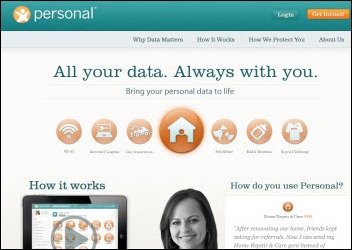'Samantha Brown points out that, “Healthcare, like every other industry, gets caught up in the idolatry of the ‘innovators.’”' I…
News 6/29/11
French IT services vendor Capgemini is looking for IT services acquisitions in the US, particularly in the healthcare sector. Says the CEO, “We are a marginal player in several of the key markets. For instance, we are non-existent in healthcare in the US, which I think is a mistake. So we need acquisitions.” You may recall that Cap bought Ernst & Young Consulting in 2000, stuck their name on it (above), then sold it to Accenture five years later after losing a ton of money. I worked with E&Y quite a bit at a previous hospital employer back in their heyday and they were excellent for strategic planning, IT governance stuff, and security work. I had a couple of occasions to work with Cap and they were clueless.
From Susan: “Re: Kettering Medical Center (OH). Went live on Epic May 1 on inpatient, ambulatory, and revenue cycle.” The video is here.
From CloseToEpic: “Re: Epic. Heard from a Madison, WI apartment owner that Epic has hired approximately 2,000 new employees who will be starting end of summer. Apartments filling up around Madison.” Unverified, but reasonable.
From WildcatWell: “Re: Google PHR dead. Told ya so. Give a brother some love! Your EMR/EHR insight is THE industry leader. Let’s get all your readers together – I’ll buy the first round.” WCW is a good information source, but I notice that his drink offer was made anonymously.
From Academic CIO: “Re: HIStalk’s eighth birthday. You have really created a resource that, on top of the insight, information, and perspective you deliver, has replaced the trade mags we used to read to try to get a handle on what was happening in the industry (and which were really only giving the vendor-approved view anyway).” I really appreciate those kind words – thanks. The best part about it is getting to connect with some really interesting people and to help bring a variety of opinions to the table.
HIStalk Announcements and Requests
Inga’s taking a semi-break, so I’m soloing this time around. She’ll be back shortly.
Vince Ciotti poses this (easy) question: “What vendor spends (wastes?) the most of its clients’ money on extravagant architecture and frivolous artwork?” Examples above from Vince’s collection.
Ed Marx added an update to his June 15 post with responses to reader comments.
Sentara Healthcare (VA) contracts with TeleHealth Services for its interactive patient education solution.
SSM Health Care (MO) contracts with revenue cycle solutions vendor Passport Health Communications for SaaS-based eligibility and financial screening solutions and services for its 15 hospitals.
People
Practice Fusion names Cora M. Tellez to its board. She’s the former president of Health Net and CEO of Blue Shield of California-Bay Region.
Mark Lederman, formerly VP/CIO at Interfaith Medical Center (NY), has been named VP/CIO at Chilton Hospital (NJ). We swap e-mails occasionally and he sent over the update, so congratulations to Mark.
Announcements and Implementations
UMass Memorial Health Care (MA) integrates MyCareTeam’s MCT Clinical diabetes management system with its Allscripts ambulatory EHR, enabling patients to upload their glucose readings.
Chicago mayor Rahm Emanuel announces that Allscripts will add 300 new jobs in the city by the end of 2012. The company will also host its annual user convention at McCormick Place starting next year.
UPMC implements Oracle GoldenGate with Cerner’s 724Access software to help reduce potential EMR downtime.
A Bama Buddy find: a hospital reports that a batter’s box-type outline made of duct tape outside the rooms of infected patients helps reduce infections, reminding employees about contact precautions and giving them a safe zone in which they can still interact with patients without gowning up.
Allscripts announces Allscripts RCM Services at HFMA, which it describes as a cloud-based, outsourced business office for physician practices that is charged as a percentage of monthly collections.
Government and Politics
CMS selects The Lewin Group for a project to reduce the number of hospital readmissions for Medicare beneficiaries and improve quality outcomes for patients transitioning from hospitals to other care settings. The company, which is part of OptumInsight, will receive $2.3 million for the first year of the five-year program.
California lawmakers put together a bill that would require clinicians to flag any information they change in electronic medical records. The bill originally required all changes to be identified by user and to let patients see changes to their own records, but those requirements were removed after big healthcare organizations expressed their opposition that California’s standards would then differ from federal standards.
Deborah Peel MD of Patient Privacy Rights sent a link to this story about Personal, a soon-to-be-launched site that lets consumers store information about themselves and then sell it to commercial organizations willing to pay for it. It’s 100 “gems” include such information as when your next oil change is due and what kind of food you like, which they’ll broker on your behalf for 10% of the proceeds. It has some big-time financial backers. Her interest: something like that could give consumers control of their healthcare information, which is being freely sold without their consent for purposes not necessarily in their best interests. It could be used like a PHR, where people enter information that could be made available to sell (to companies) or to providers (for free).
Technology
The Robert Wood Johnson Foundation introduces an online directory that includes performance measurements for hospitals and doctors. It links 197 reports with information on outcomes, cost of care, and whether patients received recommended tests and treatments.
Other

The LA Times picks up the story reported here awhile back, in which a premature baby was killed by sodium chloride overdose due to a data entry error into a hospital pharmacy’s IV compounder software. The article tries to link that human error to IT safety in general, but the problem really was a lack of IT: Advocate Lutheran General Hospital apparently had no interface between its pharmacy system and the compounder software, so they let unlicensed personnel (pharmacy techs) do the manual data entry, where it’s pretty easy to accidentally swap the values of the electrolytes (although properly installed software should have given a warning). I’ve seen that problem first hand (unfortunately) and developed a simple but elegant solution (fortunately). If you’re a CIO, e-mail your pharmacy director and ask how IV formulas get to Abacus or whatever IV compounding software your hospital uses and whether they have warnings set up in it.
1-800 Labwear brings out a lab coat with outside pockets specifically designed to hold an iPad (which they spell incorrectly).
Sponsor Updates
- Kony is named the Most Innovative Company of the Year by the American Business Awards in the technology company category.
- Hayes Management Consulting adds a Regulatory and Compliance services division that will focus on federal healthcare mandates, HIPAA billing and security policy, EDI V5010, and ICD-10. Anita Archer will lead the division.
- Northeast Valley Health Corporation (CA) and Community Health Center Network (CA) are among 32 community health centers to select NextGen EHR solutions.
- Vitalize Consulting Solutions earns an average score of 88.62 in its five service areas as measured by KLAS in its mid-term performance review.
- T-System celebrates its 15-year anniversary.
- Northern Virginia Regional Health Information Organization (NoVaRHIO) launches a pilot program with Picis that will allow ED clinicians from Inova Alexandria Hospital ED clinicians to quickly access prescription information.
- Medicity’s Health Information Exchange Solution for hospitals receives Federal Certification for meaningful use.
- Inland Northwest Health Services announces that the Spokane Virtual Lifetime Electronic Record (VLER) pilot is now enabling the secure exchange of electronic health information using the Nationwide Health Information Network (NwHIN) Exchange. The use of VLER improves the portability of health information to Veterans and active duty Service members in the Spokane, WA area.
- CMS awards the Medicare Part D Transaction Facilitator contract to RelayHealth.
- Orthopedic Institute (SD) chooses the SRS EHR for its 38 specialty providers.
- East Liverpool City Hospital (OH) goes live on ChartMaxx by MedPlus.
- Thomson Reuters launches Infection Xpert, a clinical intelligence dashboard that combines real-time clinical surveillance information, patient information, and patient-specific reference content from Micromedex for reducing and managing hospital-acquired infections.
- Nashville’s 211 Call Center health navigator program, operated by Family & Children’s Service, chooses MyHealthDIRECT to allow operators to connect callers with available area providers specific to their needs, including the ability to search available provider appointments.
- Ness County Hospital (KS) goes live on the ChartAccess Comprehensive EHR from Prognosis Health Information Systems just four months after its selection. The hospital plans to meet Stage 1 MU requirements by the end of the year.
- Main Line Health (PA) signs a five-year extension with MobileMD for its 4D health information exchange service, which it has used since 2007 to connect four hospitals and more than 30 practices to create a virtual complete medical record.
- Workforce management software vendor Concerro licenses two labor analyses tools from Workforce Prescriptions to allow it to offer labor efficiency review services that cover scheduling practices, agency use, care delay causes, and policies that impact labor ability. Hospitals average $7 million in annual realized savings from labor misalignment. The company’s take on labor management is covered in its blog, with the latest topic being the complexity of managing hospital labor costs.
- NCR is exhibiting at HFMA this week (Booth 1420), talking about self-service solutions that improve efficiency, cost, and revenue cycle.
More Thoughts on Google Health
Nobody’s really disappointed or even surprised that Google Health is dead (actually, few have even noticed, which tells you all you need to know about its problems). The only surprise is that such an unenthusiastic effort came from one-time paradigm-buster Google in the first place.
Actually, maybe the biggest surprise is that Google is shutting Google Health down in an embarrassingly public raising of the white flag. It would be one thing if they were spending a lot of R&D money on it, but there’s no evidence of that. The app is somewhere between simple and ugly, announcements of new functionality or connectivity have come along once in a blue moon, and no lofty promises were made that it would ever be anything more than it was. Given that GOOG’s market cap is $156 billion, and that pretty much nobody was using Google Health anyway, maybe they should have just abandoned it to die quietly instead of convening a very public funeral, raising ugly questions about the cause of death.
The only real traction Google Health got was among folks who wanted to see a brash, smart, and well-funded upstart barge its way into the healthcare IT vendor mix, elbowing out the companies that have been around for decades to shake them out of their maddening complacency. In that respect, Google ironically did what the non-healthcare IT vendors are sometimes blamed for doing: it laid down a smokescreen of rosy PR, under-delivered on even modest promises, ignored the advice that users and experts were giving, and then just cut and run when the going got tough, another healthcare dabbler that should have known better.
I thought Google Health would do OK, if for no reason other than the company seemed committed to hanging in there, at least initially (they threw the stereotypical launch party at HIMSS, then went silent). But the signs were there. The inexperienced folks they put in charge were replaced by even less experienced folks. Their HIMSS booth was a joke, an empty table with a few black-and-white photocopied half sheets of paper handouts. They didn’t make any acquisitions; they didn’t create any innovative technologies; they didn’t differentiate themselves publicly from HealthVault; and they made no apparent attempt to flex their muscle with the providers, EMR vendors, and insurance companies that were sitting on the key asset needed to make their product fly: data.
Sometimes visionary companies can create a market by thinking big and solving a problem consumers didn’t even know they had (MP3 players and Facebook, for example). This wasn’t one of those times. Google Health was a solution looking for a problem, much like its high-flying and equally dead stable mate Google Buzz. If nothing else, Google Health proved that Google is just as fallible as arch-rival Microsoft in thinking it understands what customers want without bothering to actually ask them.
Here’s my epitaph for Google Health, not as a PHR expert (which I’m not, since I have little interest in them) but as an average consumer/patient.
- Google knows just one business: pushing ads in the faces of users willing to tolerate them in return for getting free access to some reasonably useful Web tools. Without large numbers of eyeballs, Google wasn’t interested, and without those useful tools, neither were the eyeballs.
- The Google Health model required massive uptake to be successful by its standards, but it was designed to address the health needs of the vocal 2% rather than the indifferent 98%. Hospitals learned that lesson long ago – if you want doctors to use CPOE, you aim your technology at the average doc (busy, struggling, and administration-suspicious), not the geeked out, administration-friendly CMIO who has little in common with them other than wearing a white coat but who sometimes can dangerously convince everyone else they speak for the majority (not like Dr. Jayne, in other words, who actually practices medicine and uses the systems she supports).
- When it comes to healthcare, consumers are not empowered, and no amount of technology will change that. They have a tiny bit of discretion when it comes to choosing a doctor, but almost none when choosing a hospital or insurance company. Cool Web tools or not, Joe Sixpack has no leverage over the massive bureaucracies of the average academic medical center or insurer.
- Those massive bureaucracies suck big time at managing their own data. The last thing they want to do is (a) share their crappy and unreliable information with patients, or (b) import unvetted patient information from some other source and then have to figure out what to do with it since they are paid for piecework, not thoughtful reflection of piles of information.
- “Health” is a good thing that everybody wants for everyone else, but “healthcare delivery” is a cutthroat fight for the financial pie. Collaborative tools are tough sell when the folks at the table are trying to stab each other in the back without being noticed, but especially so when Google didn’t even seem interested in working with them.
- The average person (be careful who you picture – the masses are not healthcare- or IT-savvy) sees his or her own healthcare as someone else’s problem. They get sick, they use someone else’s money (insurance) to see a provider, they want immediate gratification from pills or surgery, they aren’t interested in information or recommendations of lifestyle changes. Few of them study the government’s dietary recommendations, interface their bathroom scale to a computer program, or participate in online support groups. They just want to be left alone, secure in the knowledge that their poor health choices can be overcome by an insurance-assigned doctor or hospital. Any suggestion that electively unhealthy folks pay more for their healthcare than electively healthy ones is met with cries of discrimination. The only way to get their attention would be to pay them to take better care of themselves, just like giving your kid $10 for each A on their report card.
- Only a tiny number of zealots will accurately and consistently enter their health information into an online shoe box. Not only is it work, there’s no apparent payoff since most providers don’t have the time or interest to read what those folks entered (partially because the technologies they use don’t play well with others any more than those providers themselves).
- Consumers use technology for three reasons: it provides them with emotional satisfaction (Facebook), it offers them convenience (Amazon, paying bills online), or it saves them money (eBay, Groupon). Google Health and most PHRs offer none of these benefits.
- Addressing the convenience aspect requires removing the friction of healthcare delivery system transactions. They are horribly inefficient, often because the doctors, hospitals, and insurance companies themselves are horribly inefficient (which lends credence to the argument that arming either Joe Sixpack or providers with a lot of technology doesn’t necessarily make things better, particularly when it comes to patient outcomes).
- Nobody really trusts big companies all that much, and people are especially suspicious of who sees their health information. Geeks might trust Google with their entire identity, but the average person probably won’t.
Now is probably a great time to retire the term Personal Health Record. It had a questionable premise to start with, but now Google has tainted it as being a plain, static Web page that’s about as fun to use as TurboTax and a whole lot less useful.
I’m an average patient and I want nothing to do with a Google-like PHR. What I want is to be able to:
- Make electronic appointments, including being able to search for openings at multiple locations or among competing providers. I don’t want to have get on the telephone or compose an e-mail.
- Request prescription refills.
- See my lab results as soon as they are available, with a personalized explanation of what they mean.
- E-mail my doctor and get a timely response.
- Get specifically requested information to my doctor efficiently, and know that he’ll ask for the information he needs, it will remain on file in case it’s needed again, and I’ll have a say in the decisions made from it.
- Get automatic reminders for EMR-triggered events (vaccinations, next physical exam due, etc.) but with the option to suppress those that aren’t helpful.
- Manage someone else’s health with their permission, such as a child or parent.
- Earn an insurance or treatment discount for following recommendations that result in measurably improved health.
- Solicit bids or search prices for services not covered by insurance.
- View any health information recorded about me with an efficient mechanism to correct any errors.
The average PHR doesn’t do most of these things. They can’t unless providers, insurance companies, and EMR vendors can be convinced to work together. Patients don’t have the sway to make that happen. Employers might, or perhaps some kind of government mandate.
Short of that, PHRs are going to struggle since, by definition, they are trying to bring competing parties together electronically without giving them an incentive to do so. That leaves PHRs as little more than a spreadsheet on which a few consumers can record their own information that nobody will look at.
Many folks who cheerlead for PHRs do so with a vested interest instead of as a consumer. So here’s the challenge to those inclined to comment on this post: instead of the usual pedantic posturing about PHRs as a technology or a business, tell me how YOU PERSONALLY use a PHR, what benefits you’ve received, and what you wish it would do. The “experts” can’t stop talking about Google Health, but none of them so far has admitted actually using it or any other PHR.
Contacts
Mr. H, Inga, Dr. Jayne, Dr. Gregg.











There’s probably a good reason why one of the most influential HIS blog is also one of the ugliest and technologically challenged blog. What was that reason again? And why can’t you throw together a basic WordPress blog with a decent template? Appearances matter – you know.
In baby death report in LA Times, my friendly Carla of HIMSS makes statements about HIMSS Carla Smith, executive vice president of HIMSS, the industry’s largest
trade group, based in Chicago, said that “safety concerns are on our
radar screen” and “we want to make sure we have checks and balances in
place (in vendor systems) to prevent unintended harm.”
Well, you then but, what radar is she talking about?
Is this a special safety radar they just then come up with now. Was there radar for safety at HIMSS a decade ago and when they, you know then, developed that program CCHIT, which as you then, had not any interests in safety? The only safety then I heard of since moving is with FDA, but no FDAradar for HIT.
Me confused. Any one help me and say why? Thank you. This is very good blogger.
and safety: “
Bullshit on the “no one uses it” MrHISTalk. As well as being an “expert” I’m a consumer (and so is my wife) who actively used Google Health (and Healthvault). She put all her lab results in there by hand, just so she had somewhere to store them to track her condition. I use it to keep track of my prescriptions, and conditions, and put my weight (automatically via a Withings scale) into it every day (and even look at the chart now and again). If I could (and I wish I could) I’d all all my daughters immunizations and medications (when they start–she’s only 6 weeks).
Where else do I find this stuff now? Buried or locked in paper or in a non-accessible electronic format that requires physical transportation between doctors. Given that our family of 3 has three main doctors and god knows how many specialists how are we supposed to do that–and we’re not even sick!
If we had a sensible Danish-style system with a Kaiser-like for all accessible EMR, I’d be OK with your snide attitude. But given that none of us in the US have that, and that every system out there fails to share data with us, or with each other, you’re damn right I was cheering for Google, Microsoft and anyone else to break down those walls.
We all want those transactions you talk about and the data would automatically flow from them–if the hidebound screwed up health care industry provided them. The joke is that the data is slowly slowly starting to flow, mostly from the taxpayer bribing the industry and from visionaries in the government pushing the Blue Button–rather than forcing it on the molly-coddled health industry as it should. And now there may be nowhere to put it.
But the tone of your remarks have consistently been that this state of affairs is more or less acceptable. I’m pissed off with Google for cutting and running, (and props to Microsoft for hanging tough). But the customer experience delivered by the health care system remains a total disgrace, and this is no time to welcome the departure of a company that has had success improving it in other areas.
more (if you need it) over at http://thehealthcareblog.com/blog/2011/06/27/why-we-need-an-independent-health-data-utility/
So you are sitting around a table in Mountain View with a bunch of hipsters and you are thinking about whether to jump into health care. It’s 20% of the economy and you are a titan of the advertising and media industry. You don’t think PHRs are for real.
You really don’t.
But like every corporate committee you decide “we just have to see for ourselves”. So you put up an PHR, fund it a bit, and nothing happens. You watch smaller companies in the industry try and innovate, but no dice. You decide to stop spending money on the effort.
The big news is the PHRs were a flawed concept from the begining. If you are Google and you fail, that is news. In fact it may be the best test of a flat-line idea.
Their failure is the epitath. Hence the press release.
re: wasting money on architecture & artwork.
I agree Vince, I’m sure Epic would be a much better vendor if all of their employees worked in grey cubes with no signs of life or creativity. And stuff them in shipping containers for added efficiency! No architects needed for that! And clearly there’s no need for a nice training center when staff like you come to visit — there’s plenty of hotels in the area with perfectly adequate basement conference rooms with a projector, institutional catered lunches, and coffee-like brown water.
What a waste…
I can certainly appreciate Matthew Holt’s point of view. However, while he is a consumer…he is also an expert. Not enought of them out there to make a difference. I thought points 7 and 8 of the Google Health demise reasons were spot on. The market is mostly consumers who don’t appreciate (or even grasp) the value proposition offered by ideas like Google Health.
What is your solution as stated? I’ve seen that problem first hand (unfortunately) and developed a simple but elegant solution (fortunately).
This case may reflect more on the unusable nature of the systems. What was on the tech’s CPOE screen, ie how confusing was it?
Well said. Vince, why is investing in your staff and your workplace a waste? That’s the R&D engine that keeps Epic ahead of the pack consistently through the years. The cost of the buildings, the art and the grounds are trivial in comparison to the real cost of a software development company – it’s people.
Payroll dwarfs all other expenses and if you lose good people or fail to attract the best talent, you’re an idiot in this business.
Great programmers produce at a rate of 10 to 1 and some argure even higher. Creative surroundings lead to creative output. There’s science behind that.
Laugh at Epic all you want, but if you’re a competitor, it isn’t seeming so humorous right now.
oh… and if you’re an Epic customers knocking down Meaningful Use out of the gate, or Stage 7, you’re probably thinking maybe Epic’s on to something.
Re: ‘The LA Times picks up the story reported here awhile back, in which a premature baby was killed by sodium chloride overdose due to a data entry error into a hospital pharmacy’s IV compounder software.”
Another baby death – of course not due at all to any aspect of IT) is at my post at this link as case #2. In this situation, you can download the court complaint itself.
If only Google Health had as many people talking about its benefits as have talked about its demise. Maybe Google should’ve taken a line from Lyle Lovett: “I’d change my ways, if I knew what else to be.”
I used Google Health and I use HealthVault. I don’t love either one. But, Google Health was much easier to enter data into than MS’s service. It was simple and simple is good. No it wasn’t lovely and not it didn’t change much, but for getting some core info on line, it was solid.
Why’d I use it? I wanted to have all of the essential information for my family of 5 consolidated online in case one of us had a health emergency. Getting to Google.com is much easier than finding a file in a cabinet in the basement when you’re 500 miles from home.
Essential to me didn’t mean having ALL of our records online — but I consider that completely impossible. I simply used it to manually enter the insurance cards, allergies, major health issues, birthdates, surgeries, and prescriptions for me and my family. For motivating factors, that’s probably boring and even uninteresting, but isn’t that the case with a lot of “maintenance” visits in healthcare? When an annual checkup comes up positively uninteresting, isn’t that good?
I do think Google got into something it wasn’t committed to, which is the beginning of the end for all poor heathens near and far.
Re: Capgemini
Having been at Cap 6-7 years ago during the last implosion, I can’t believe they are going to make another attempt at this. Bottom line is that they just don’t understand healthcare at the top (read: France), particularly the nuances of U.S. healthcare. It was painful to work there as things starting falling apart and it’s hard for me to believe that anything will be different this time around. Put me down for $100 that it will fail in short order.
@MrHISTalk: Well said re: Google Health and PHRs.
@Matthew Holt: Don’t focus on the failings of PHRs; assume for a minute they are perfect. Focus on the political and business climate where they are attempting to be successful. Focus on the value the average healthcare consumer wants and who will pay for that value. I honestly think that MrHISTalk nailed it — both the functions desired and the climate in which PHRs need to be successful. For better or worse, healthcare is a business in our current market. Just like Wal Mart doesn’t want to give Target a list of communities where new stores are planned, care givers want “lock in” of their patients. The sad reality is that data moved and shared is BOTH more efficient and business lost to a current provider. It is a really hard problem to fix.
@Vince Ciotti: Please read the book “Peopleware: Productive Projects and Teams” or related resources. Clearly there is a wide, gray line between “clearly wasteful” and “fun and motivating.” Each company must decide where they will be within the grayness. Broadly speaking, the average employee would prefer cool (yet not extravagant) architecture and an interesting environment in which to work to a huge board room or fancy desks in opulent executive offices. The latter is my personal pet peeve: The CXOs (especially in healthcare IT at providers; ignore the vendors) have huge offices with large decorating budgets while the grunts have cubes, flickering overhead lights, small single-monitor desktops, and box fans running to keep the computers cool in the machine room. In short, make the grunts happy; they do critical work; don’t go overboard on environment yet make it “fun”, “nice”, and/or “professional” to fit the team’s culture and budget.
Re Mr. HISTalk’s list of things he wants to be able to do with his info. I have Kaiser. Their Epic / MyChart rollout has made most of the things on Mr. H’s list possible (and easy, in most cases). I have received care from multiple providers in the Kaiser system in a couple of different specialities. Each can see what the others have done for me. Each see what meds I’m taking. Any Kaiser pharmacist who evaluates my online refill order can see everything I’m taking or have taken. This kind of data integration is thoroughly routine in many of the other commercial interactions we all have, with banks, shopping sites, sporting goods stores, utility companies, airlines, etc. One suspects most HISTalk readers have never experienced use of integrated data like this. One imagines that the consumer expectation for this kind of data will be the new bar for all providers. The point about data integration and care for someone else is a big one for the sandwich generation: If you are caring for an elderly parent and don’t have this kind of data integration (because they are being treated piecemeal by different providers, outside of a system), you’ll have a really big notebook to carry around with you to their appoints, or a laptop with scanned copies of every single visit and scrip your parent has had over the last 2-3 years.
Mr. H list:
1. Make electronic appointments, including being able to search for openings at multiple locations or among competing providers. I don’t want to have get on the telephone or compose an e-mail. — Yep, and it’s a huge timesaver.
2. Request prescription refills. — Yep, and can choose to have them sent via mail (cheaper), or available at a Kaiser pharmacy of my choosing (if I’m in a hurry)
3. See my lab results as soon as they are available, with a personalized explanation of what they mean. — Mostly, yes. Labs are available unless dire. I don’t believe Kaiser puts up positive cancer or STD labs up on the web portal – the doc calls.
4. E-mail my doctor and get a timely response. – Yep, and my doc is responsive, if understandably terse.
5. Get specifically requested information to my doctor efficiently, and know that he’ll ask for the information he needs, it will remain on file in case it’s needed again, and I’ll have a say in the decisions made from it. — Yep, and a lot of that comes from population management, not driven just by my doc’s decisions. E.g., two asthma inhaler refills led to a survey about degree to which my asthma was under control. Data-driven rather than physician-memory-driven = good.
6. Get automatic reminders for EMR-triggered events (vaccinations, next physical exam due, etc.) but with the option to suppress those that aren’t helpful. — Yep. Got reminders about colon cancer screening. The reminders worked.
7. Manage someone else’s health with their permission, such as a child or parent. – Yep – I have the option, and have used for my child.
8. Earn an insurance or treatment discount for following recommendations that result in measurably improved health. — Haven’t seen this one yet, but there is plenty of encouragement to be healthy, and the population management focus I mentioned.
9. Solicit bids or search prices for services not covered by insurance. – Haven’t looked. Not really a botox or augmentation person…
10. View any health information recorded about me with an efficient mechanism to correct any errors. — Don’t know about this one, but I’ll look. Good question.
Interesting how Allscripts takes credit for adding 300 jobs in Chicago. They silently canned about that many in operations and account managers right after the Eclipsys merger, not to mention all the staff they lost because of voluntary walk-offs.
Glen’s continuing publicity stunts never cease to amaze me. Allscripts is adding 300 jobs….but there’s no mention of the massive cuts or understaffing (that has led to clients missing MU upgrades)? HISTalk should feature a story on Allscripts’ smoke & mirrors.
Allscripts 300 jobs in Chicago? The exec team is turning over and they have time for a photo op with Rahm? Typical.
Allscripts 300 jobs in Chicago? They might actually pull a workforce back from Overseas and start addressing client needs?
Judy is known for buying lots of local art – and Epic and Meditech put their earnings into owning their buildings.
I’d bet that both own VS rent and certainly all the art shown total a lot less than the lawyer, investment banker, and accounting fees associated with public offerings and more public offerings. Oh…forgot that Epic doesn’t spend the millions on advertising that Allscripts does or have a sales force of 50 like some companies. Sorry…both companies are doing something right – both by their clients and employees.
Allscripts 300 jobs in Chicago. NONE of them are in support. Atleast the company finally admited to its employees outside of support that they they aren’t getting help anytime soon. Support was told months ago about the shift towards India. So, unless you consider more employees in India help, its not going to happen. Alot of tenured employees are starting to hit the door or are being forced to the door.
re: “What vendor spends (wastes?) the most of its clients’ money…”
Wonder what you would think if your employer starts questioning how you spend your paycheck. You got paid for your services, it’s your decision how to spend your money. Vendors aren’t spending your tax dollars.
I am pretty sure that posts related to Epic generate the most traffic on your blog. Unfortunately, I find most comments related to Epic on your blog to be misguided or misinformed.
How Epic spends its fairly earned money is nobody’s business. Of course, people fail to realize that it is hard to attract smart programmers to write code for enterprise healthcare in the middle of nowhere, especially when start ups in California offer everything under the sun. Even Groupon had to open a development office in California because it could not find smart programmers to come to Chicago. A creative and attractive campus goes a long way to improve Epic’s competitiveness in the market of young, smart programmers.
The biggest concern with Epic should not be what it is doing wrong right now (there ain’t much), but will it be able to sustain this post its founders? Usually, companies with strong cultural bearings and charismatic top leaders don’t do well beyond their founders.
Epic is entitled to spend their money how they like. I personally think they choose to spend it in a tacky, and misguided way. I really take issue with the idea that the Verona environment is conducive to innovation, and not because of the science mentioned in earlier posts. I agree that a creative environment stimulates creativity in employees. The Epic-favorable story is that they have a creative environment to innovate. The Epic-unfavorable story is that they have to have something to convince college kids to move to the middle of nowhere and work like mad dogs to get product out the door. There’s no innovation there either, not even MyChart (ask Gio Colella), which is only an Epic PHR, not a universal PHR like Google Health was trying to be. What good is a PHR if it’s not portable through any and all health care settings? Building a different screen on top of your same “integrated” data set is a gimmick with limits on its long-term effectiveness. They’ve already started to deviate from that model with Obix, aka Stork, and Imprivata and will continue to try to mold in 3rd party software into their system. It’s no more patient-centric or integrated than any other major vendor system on the market really. It’s just amazing to me what hospitals are spending to clamber onto the Epic bandwagon without having a plan past the next 5 years.